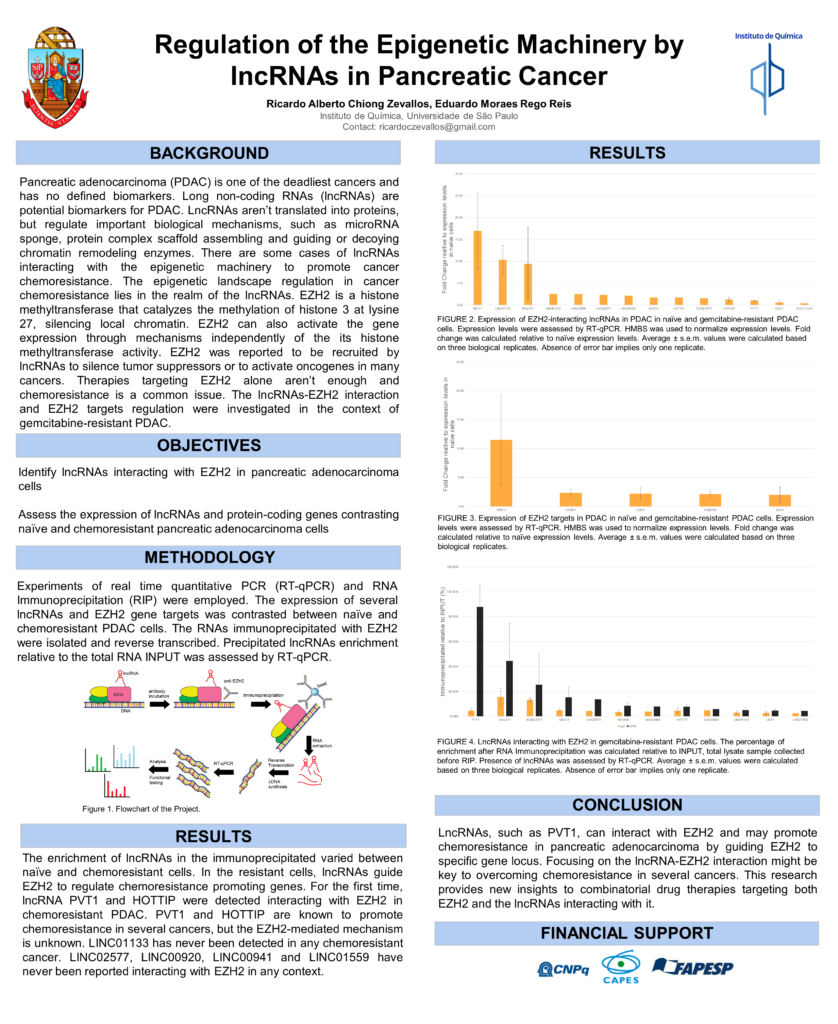Ricardo A. C. Zevallos
Conference 2023 Presentation
Project title
Regulation of the epigenetic machinery by lncRNAs in pancreatic cancer
Authors and Affiliations
Ricardo Alberto Chiong Zevallos1, Eduardo Moraes Rego Reis1
1. Department of Biochemistry, Institute of Chemistry, University of São Paulo, São Paulo, Brazil
Abstract
Background
Pancreatic adenocarcinoma (PDAC) is a deadly cancer with a less than 10% 5-year survival rate. Tumor resection is the most beneficial intervention and chemotherapy shows little efficacy. The first-line drug, gemcitabine, is also employed in many other cancers. PDAC lacks precise diagnostic and prognostic biomarkers. Among the poorly understood potential biomarkers, there are long non-coding RNAs (lncRNAs). These transcripts aren’t translated into proteins, but have multiple functions, including regulation of the epigenetic machinery. Some lncRNAs can guide enzymes to specific gene locus to catalyze histone modifications or act as decoy, abrogating the protein’s function. EZH2, a histone methyltransferase of Polycomb repressive complex 2 (PRC2), is overexpressed in numerous cancers and catalyzes the methylation of histone H3 at lysine 27. EZH2 can activate gene expression independently from PRC2. EZH2 is responsible for non-histone protein methylation, regulating the Wnt signaling pathway among others. The EZH2’s role in oncogenes and tumor suppressors regulation lies in the realm of the lncRNAs. The epigenetic landscape regulation by lncRNAs associated with chemoresistance is at the frontier of knowledge.
Methods
Gemcitabine-resistant cells derived from PDAC cell line AsPC-1 were submitted to gene expression analysis and RNA immunoprecipitation (RIP) experiments. The expression of several lncRNAs were contrasted between parental and resistant cells by real time PCR. Next, RIPs were employed to investigate the interaction of lncRNAs that might guide EZH2 to regulate genes associated with the chemoresistance. In RIPs, an antibody for EZH2 was incubated with the nuclear fraction of AsPC-1 and precipitated with magnetic beads. The RNAs attached to the EZH2-antibody-beads complex were isolated. The presence of several lncRNAs was assessed by reverse transcription followed by qPCR.
Results
The expression of the lncRNAs and the percentage of RNA recovered after RIP varied between naïve and chemoresistant cell lines. This is the first report of EZH2 interacting with the lncRNA PVT1 in chemoresistant PDAC. PVT1 is associated with resistance in several cancers, but its contribution in PDAC is not yet clarified.
Conclusions
The interaction with EZH2 suggests that PVT1 might play a role on the epigenetic reprogramming leading to chemoresistance in PDAC and other cancers. This finding opens the gates to new combinatorial therapies targeting EZH2 and the lncRNAs guiding it.

